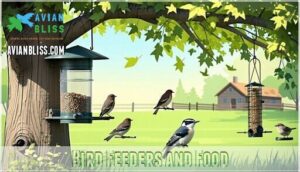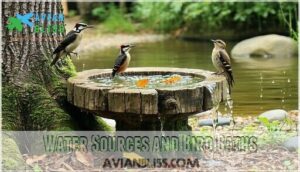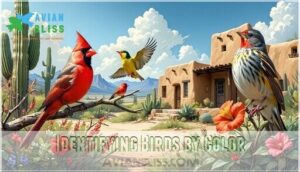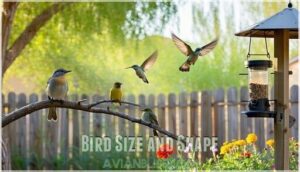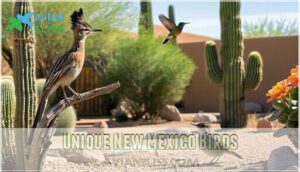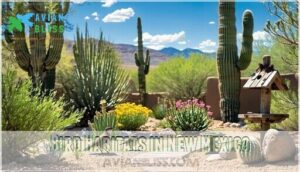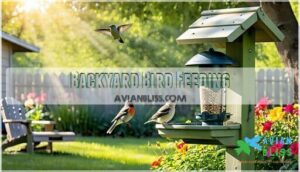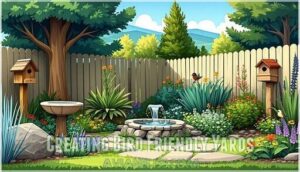This site is supported by our readers. We may earn a commission, at no cost to you, if you purchase through links.

Common year-round residents include House Finches, Curve-billed Thrashers, and Gambel’s Quail in desert areas, while Mountain Chickadees and White-breasted Nuthatches prefer higher elevations.
The iconic Greater Roadrunner might sprint through your property, and tiny Broad-tailed Hummingbirds hover at feeders.
Seasonal visitors like Ruby-throated Hummingbirds arrive in spring, adding excitement to your birding experience.
Your elevation and habitat type determine which species you’ll encounter most often, and the right feeders and native plants can transform your space into a bustling avian highway.
Table Of Contents
- Key Takeaways
- New Mexico Bird Species
- Attracting Backyard Birds
- Bird Identification Tips
- Unique New Mexico Birds
- Bird Habitats in New Mexico
- Backyard Bird Feeding
- Creating Bird Friendly Yards
- Frequently Asked Questions (FAQs)
- What are the most common backyard birds in New Mexico?
- What are the smallest birds in New Mexico?
- Are there endangered birds in New Mexico?
- How do I attract more birds to my yard in New Mexico?
- What is the most common bird in New Mexico?
- How do I identify a bird in my backyard?
- What is New Mexico’s national bird?
- What is the rarest bird in New Mexico?
- What is the famous bird in New Mexico?
- What is the long legged bird in New Mexico?
- Conclusion
Key Takeaways
- You’ll spot 30-40 bird species regularly in your New Mexico backyard, including year-round residents like House Finches and Dark-eyed Juncos, plus seasonal visitors like Black-chinned Hummingbirds that follow predictable migration patterns.
- You can attract more birds by providing three essentials: multiple feeder types with black-oil sunflower seeds, fresh water sources like shallow birdbaths, and native plants like piñon pine that offer natural food and nesting sites.
- You’ll identify New Mexico birds more easily by focusing on key features like plumage color patterns, body size and shape, and bill structure—distinguishing between seed-cracking finches with thick beaks and insect-hunting wrens with thin, pointed bills.
- Your elevation and habitat type determine which species you’ll see most often, with desert areas hosting Roadrunners and Gambel’s Quail, while higher elevations attract Mountain Chickadees and White-breasted Nuthatches.
New Mexico Bird Species
You’ll find over 550 bird species throughout New Mexico’s diverse habitats, from desert scrublands to mountain forests, with many species adapting to backyard environments year-round.
New Mexico’s 550+ bird species transform ordinary backyards into year-round wildlife sanctuaries across diverse desert and mountain landscapes.
The state’s unique geography creates distinct resident populations like the Greater Roadrunner (Geococcyx californianus) and seasonal migrants including Black-chinned Hummingbirds (Archilochus alexandri) that follow predictable patterns you can observe from your own yard.
Year-Round Resident Birds
When exploring backyard birding in New Mexico, you’ll discover several reliable year-round residents that call the Land of Enchantment home.
These resident bird species don’t follow typical bird migration patterns, staying throughout all seasons. Dark-eyed Juncos, American Robins, and House Finches represent common New Mexico birds with consistent resident bird habits.
The Northern Flicker also maintains year-round presence in many areas. New Mexico’s unique bird species diversity contributes to its appeal for backyard birders.
Seasonal Bird Visitors
New Mexico’s seasonal bird visitors follow predictable migration patterns throughout the year.
Spring migration brings violet-green swallows and warblers from Central America, while summer visitors include black-chinned hummingbirds and western tanagers.
Fall flocks feature bullock’s orioles preparing for southern journeys, and winter roost species like northern shrikes and rough-legged hawks arrive from northern territories, creating dynamic backyard birding opportunities year-round.
Understanding local bird migration patterns can enhance the overall birding experience.
Common Backyard Birds
You’ll spot these New Mexico backyard birds most frequently at your feeders and in your yard.
Western Tanagers, Red-winged Blackbirds, and Great-tailed Grackles top the list for regular sightings.
Dark-eyed Juncos and Mountain Chickadees visit year-round, while Yellow-rumped Warblers and White-winged Doves show predictable flocking behavior.
These bird species adapt well to backyard environments and bird feeders.
Attracting Backyard Birds
You can transform your yard into a bird sanctuary by providing three essential elements: food sources, fresh water, and suitable nesting sites.
Creating this habitat combination will attract species like Dark-eyed Juncos, American Robins, and White-winged Doves to visit your outdoor space regularly, making it a welcoming place for various species.
Bird Feeders and Food
Now that you’ve spotted New Mexico’s backyard birds, you’ll want to roll out the red carpet with the right bird feeders and food.
Different species have unique dietary preferences, so understanding bird nutrition helps you attract specific visitors to your yard.
- Tube feeders filled with black-oil sunflower seeds attract the widest variety of species
- Suet feeders provide high-energy food supplements for woodpeckers and nuthatches
- Platform feeders offer generous space for multiple birds to dine together
- Hopper feeders require fewer refills thanks to their large seed capacity
Using the right bird feeding options is essential for attracting various bird species to your yard.
Water Sources and Bird Baths
Fresh water draws New Mexico birds like magnets to metal. You’ll attract Dark-eyed Juncos, American Robins, and House Sparrows with shallow birdbaths positioned three feet high.
*Water is the secret ingredient that transforms any yard into a bustling bird paradise.
Bird Ponds and fountain systems create irresistible drinking spots, while rain barrels provide consistent water sources during dry spells.
Clean your water features weekly to prevent algae buildup and keep backyard birds healthy and hydrated. Incorporating native bird bath plants can enhance the overall bird-friendly environment in your yard, creating a perfect spot for backyard birds.
Native Plants and Birdhouses
Plant selection matters when attracting New Mexico birds to your backyard.
Choose native species like four o’clock, desert willow, and pinyon pine that provide natural food sources and nesting sites.
Strategic yard layout combines these plants with properly designed bird houses placed 5-6 feet high.
This native gardening approach supports wildlife conservation while creating perfect habitat for backyard birds seeking shelter near your bird feeders, which is essential for wildlife conservation.
Bird Identification Tips
You’ll identify New Mexico’s backyard birds more easily when you focus on three key features: plumage color patterns, body size and shape, and bill structure.
These field marks help distinguish between similar species like the slate-gray Dark-eyed Junco and the brownish House Sparrow, or separate the long, curved bill of a Canyon Wren from the short, seed-cracking beak of a House Finch, which are important for identifying similar species and understanding the significance of bill structure.
Identifying Birds by Color
Color serves as your first clue when identifying new mexico birds in your backyard.
Focus on these key features to distinguish bird species effectively:
- Plumage Patterns – Notice overall light and dark arrangements across the body
- Wing Markings – Look for distinctive patches, bars, or spots on wings
- Beak Hues – Observe bill coloration variations between species
Feather Colors and Tail Shades provide essential identification markers for backyard birds and bird coloration analysis.
Bird Size and Shape
Size matters when identifying New Mexico bird species in your backyard.
Bird silhouettes reveal key clues about body proportions and wing spans. A robin’s chunky build differs dramatically from a finch’s compact frame.
Notice how a hummingbird’s tiny proportions contrast with a dove’s rounded body.
These physical characteristics, combined with feather patterns, make bird identification much easier for beginners, using key clues about body proportions.
Beak Shape and Leg Color
Bird beaks tell the story of what they eat.
Seed-cracking finches sport thick, cone-shaped bills, while insect-hunting wrens have thin, pointed beaks.
Hummingbirds’ needle-like bills reach deep into flowers.
Leg colors matter too—most New Mexico bird species show yellow, orange, or black legs.
These bird adaptations help you identify backyard birds quickly during bird watching sessions.
Understanding bird identification techniques is essential for accurate species recognition.
Unique New Mexico Birds
You’ll find several bird species in New Mexico that don’t appear in most other states, making your backyard a special place for birdwatching.
The Greater Roadrunner (Geococcyx californianus) stands out as the state bird, while desert-adapted species like the Cactus Wren and various hummingbird species thrive year-round in the unique high desert climate.
Roadrunners and Hummingbirds
New Mexico’s most iconic Desert Birds showcase fascinating contrasts in your backyard.
The Greater Roadrunner, our state bird, thrives in Roadrunner Habitat without needing water sources.
Meanwhile, Blackchinned Hummingbird and Rufous Hummingbird species require constant Hummingbird Feed during Bird Migration seasons.
These backyard birds demonstrate remarkable Feather Care adaptations, making New Mexico birding exceptionally rewarding for patient observers.
By recognizing common bird species, such as those with bright plumage patterns, enthusiasts can better appreciate the diversity of birds in their area.
Woodpeckers and Wrens
Hammering through your morning coffee routine, you’ll spot New Mexico’s woodpeckers creating tree cavities with their distinctive bird drilling.
Downy Woodpeckers showcase classic woodpecker behavior, while House Wrens deliver complex melodies showcasing varied wren songs.
These backyard birds demonstrate fascinating nesting habits – woodpeckers excavate precise holes, wrens stuff cavities with twigs, creating bustling neighborhood soundtracks.
Birds of Prey and Owls
Raptors rule New Mexico’s skies with impressive hunting skills.
You’ll spot Cooper’s Hawks during hawk migration seasons, while Great Horned Owls display fascinating owl habits year-round.
The Northern Pygmy Owl hunts during daylight hours, breaking typical raptor behavior patterns.
These bird predators play vital roles in falcon conservation efforts.
Watch for Red-tailed Hawks soaring overhead – they’re common New Mexico bird species perfect for bird watching enthusiasts.
Bird Habitats in New Mexico
You’ll find New Mexico’s diverse landscapes create distinct bird habitats that attract different species throughout the year.
The state’s deserts, mountains, and urban areas each support unique bird communities, from roadrunners in arid zones to mountain chickadees in high elevations.
Desert Bird Habitats
New Mexico’s arid landscapes create unique bird habitats where desert ecology thrives.
Sandy dunes and cactus habitats support specialized bird species like Cactus Wrens and Roadrunners.
These desert birds have adapted to extreme conditions, requiring minimal water while finding shelter in thorny vegetation.
During bird migration seasons, over 300 species pass through these harsh yet essential backyard bird environments.
Mountain Bird Habitats
Higher elevations in New Mexico’s Mountain Ecosystems create unique Forest Habitats where Alpine Birds thrive year-round.
You’ll discover Highland Species like the mountain bluebird traversing rocky terrain with ease. These Cliff Dwellers adapt to harsh conditions that lowland backyard birds can’t handle.
Key mountain bird characteristics include:
- Specialized feeding – Seeds from pine cones and high-altitude insects
- Cold adaptation – Dense feathering for temperature regulation
- Altitude tolerance – Efficient oxygen processing at 7,000+ feet elevations
Urban Bird Habitats
Urban areas in New Mexico create surprising havens for backyard birds when you know where to look.
City parks and urban trees form essential bird corridors that connect fragmented habitats.
Green roofs and backyard habitats provide essential nesting sites, while bird feeders supplement natural food sources in developed neighborhoods.
| Habitat Type | Common Species | Attracting Features |
|---|---|---|
| City Parks | American Robin, House Sparrow | Open lawns, mature trees |
| Urban Trees | Dark-eyed Junco, Mourning Dove | Nesting cavities, perching sites |
| Green Roofs | House Finch, White-crowned Sparrow | Native plants, water retention |
| Backyard Gardens | Barn Swallow, Black-chinned Hummingbird | Feeders, flowering plants |
| Commercial Areas | Common Grackle, Rock Pigeon | Food scraps, building ledges |
These urban oases support New Mexico wildlife refuge networks by providing stepping stones for migrating species and permanent homes for resident populations.
Backyard Bird Feeding
You’ll attract more avian species to your yard when you provide consistent food sources that match their dietary preferences and feeding behaviors.
Setting up different feeder types with species-specific seeds, suet, and nectar creates feeding stations that’ll bring Dark-eyed Juncos, House Finches, and Black-chinned Hummingbirds right to your window, providing a consistent source of food.
Types of Bird Feeders
You’ll find five main feeder types that attract New Mexico’s diverse backyard birds effectively.
Each design targets specific feeding behaviors and bird species in your yard.
- Tube Feeders: Cylindrical designs with multiple perches for finches and chickadees
- Hopper Feeders: House-shaped dispensers ideal for cardinals and jays
- Platform Feeders: Flat surfaces accommodating ground-feeding sparrows
- Suet Feeders: Wire cages holding fat blocks for woodpeckers
- Hummingbird Feeders: Nectar dispensers with red accents
When selecting a feeder, consider the bird feeder types that will best attract your desired bird species.
Bird Seed and Suet
Black-oil sunflower seeds attract cardinals and finches to your New Mexico yard. Safflower seeds draw mourning doves and sparrows, while cracked corn brings blue jays.
Suet feeders provide essential winter fat for woodpeckers and nuthatches. Store birdseed in sealed containers to prevent spoilage.
Combine seed types in feeders or create homemade suet recipes with peanut butter and cornmeal for ideal bird nutrition. Choosing the right bird seed types is vital for attracting a variety of bird species to your yard.
Nectar and Fruit Feeders
Specialized nectar and fruit feeders transform your yard into a hummingbird haven.
These sugar mixtures attract New Mexico bird species like Black-chinned Hummingbirds while providing essential energy sources.
- Nectar recipes: Mix one part white sugar with four parts water
- Fruit types: Offer oranges, grapes, and native berries
- Feeder designs: Choose red tubular feeders with multiple ports
- Bird attractions: Position feeders near flowering plants for maximum visibility
Creating Bird Friendly Yards
You can transform your yard into a bird habitat by selecting native New Mexico plants like piñon pine and four o’clock flowers that provide natural food sources and nesting sites.
Installing properly positioned birdhouses and adding a simple water feature will create the three essential elements that attract species like Dark-eyed Juncos and American Robins year-round, utilizing native plants for natural food sources.
Native Plant Landscaping
You’ve got the feeding stations covered, now let’s talk Desert Gardening.
Native Seeds from common juniper, chokecherry, and chamisa create Plant Diversity that attracts New Mexico birds naturally.
Your yard becomes a New Mexico wildlife refuge when you choose plants matching your climate zone for authentic bird attraction, building a Wildlife Habitat that supports native birds year-round.
Birdhouse Installation
Beyond plants, proper birdhouse installation creates secure nesting sites for New Mexico wildlife refuge species.
Strategic placement attracts backyard birds that won’t visit bird feeders but need safe homes. When selecting materials, consider New Mexico birdhouse designs to guarantee the best results.
Your birdhouse setup requires these key elements:
- Entrance holes sized for target species – 1.25" for wrens, 1.5" for chickadees
- Mounting kits positioned 5-15 feet high on poles or trees
- Roof designs with overhangs protecting from desert sun and rain
- Nesting boxes following proven birdhouse plans for cavity-nesters
Water Feature Installation
Water feature installation transforms your yard into a New Mexico bird magnet.
You’ll attract more backyard birds with proper birdbath design and fountain systems than feeders alone.
Position water pumps strategically for gentle circulation, preventing mosquito breeding.
Consider pond installation for larger species or rainwater harvesting systems.
Moving water creates irresistible sounds that draw diverse bird species year-round.
Frequently Asked Questions (FAQs)
What are the most common backyard birds in New Mexico?
You’ll frequently spot feathered friends like Dark-eyed Juncos, Western Tanagers, and Red-winged Blackbirds visiting your yard.
White-winged Doves, Mountain Chickadees, and the iconic Great Roadrunner also make regular appearances throughout New Mexico’s diverse landscapes.
What are the smallest birds in New Mexico?
You’ll spot several tiny species in New Mexico’s diverse habitats.
Black-chinned Hummingbirds measure just 3-4 inches, while Golden-crowned Kinglets reach 4 inches.
House Wrens and Chipping Sparrows are also among the state’s smallest birds.
Are there endangered birds in New Mexico?
Yes, you’ll find endangered species here.
Several threatened birds call New Mexico home, including the Mexican Spotted Owl and Southwestern Willow Flycatcher.
You can help by protecting their habitats and reporting sightings to local wildlife authorities.
How do I attract more birds to my yard in New Mexico?
Provide fresh water in shallow dishes, hang multiple seed feeders at different heights, plant native berry-producing shrubs, and create brush piles for shelter.
You’ll attract Dark-eyed Juncos, House Finches, and other local species year-round, which includes attracting them with native berry-producing shrubs.
What is the most common bird in New Mexico?
Dark-eyed delights dominate New Mexico’s skies.
You’ll spot Dark-eyed Juncos most frequently—they’re the state’s champion with over 600 million across North America.
These slate-gray beauties with white bellies visit feeders year-round throughout your neighborhood.
How do I identify a bird in my backyard?
Look for size, color patterns, and behavior first.
Note the bird’s shape, beak type, and tail length.
Check field markings like wing bars or eye rings.
Use a field guide or birding app to confirm your identification.
What is New Mexico’s national bird?
New Mexico’s state bird is the Greater Roadrunner, officially designated in You’ll recognize this desert-dwelling cuckoo by its brown plumage with black streaks and distinctive X-shaped footprints in sand.
What is the rarest bird in New Mexico?
Finding the rarest bird feels like searching for a needle in a haystack!
You’ll struggle to spot endangered species like the Mexican Spotted Owl or Southwestern Willow Flycatcher without precise field knowledge and exceptional luck.
What is the famous bird in New Mexico?
The Greater Roadrunner stands as New Mexico’s most famous bird, serving as the official state bird since
You’ll recognize this desert speedster by its brown-streaked plumage and distinctive X-shaped footprints in the sand.
What is the long legged bird in New Mexico?
Like desert sentinels standing tall, you’ll spot the Greater Roadrunner strutting across New Mexico’s landscape.
This iconic cuckoo species reaches two feet in height, displaying distinctive X-shaped footprints while hunting lizards and small mammals, showcasing its unique characteristics as a cuckoo species.
Conclusion
Picture your yard as a rest stop along a transcontinental highway—backyard birds of New Mexico treat your space exactly that way.
You’ve learned to identify species by size, color, and beak shape, discovered which feeders attract specific birds, and understood how elevation affects your visitors.
By installing native plants, providing fresh water, and maintaining consistent food sources, you’ll transform your property into a reliable waystation.
Soon you’ll count dozens of species calling your yard their regular destination.

